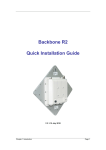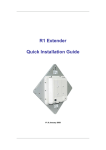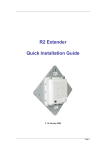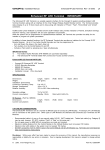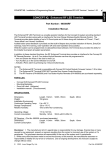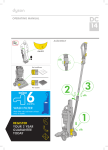Download Sagittar SGT-LD-5-23 Installation guide
Transcript
SGT-LD-5-23 Quick Installation Guide V2.1.10 October 2010 Copyright Copyright © 2010 - all rights reserved. No part of this publication may be reproduced, adapted, stored in a retrieval system, translated into any language, or transmitted in any form or by any means without the written permission of the supplier. About the Installation Guide This Installation Guide is intended to guide a professional installer to install the SGT-LD-523. It includes procedures to assist you in avoiding unforeseen problems. Conventions Warning: This indicates a warning or caution that you have to abide by. Note: This indicates an important note that you must pay attention to. Chapter 1 Introduction Introduction The SGT-LD-5-23 is a high-performance outdoor-deployable radio bridge that provides radio connectivity amongst multiple network locations. The SGT-LD-5-23 has support for Base Station, CPE, PTP and PTMP connectivity modes. Moreover, the SGT-LD-5-23 has a built-in 23dBi flat-panel antenna that can be used for connections in excess of 40km. With high throughput and long-distance transmission, the SGT-LD-5-23 is an ideal backhaul solution for Carriers, Enterprises and Service Providers. Chapter 2 Preparation before Installation This chapter describes safety precautions and product information that you have to know and check before installing a SGT-LD-5-23. Professional Installation Required 1 Please seek assistance from a professional installer who is well trained in RF and network installation and who is knowledgeable regarding local regulations. 2 The SGT-LD-5-23 is provided through distribution to system installers who employ services of trained professional technicians – the SGT-LD-5-23 is not sold directly through retail stores. Safety Precautions To ensure your safety and install the hardware properly, please read and follow these safety precautions. 1 If you are installing an antenna for the first time, for your safety as well as others, please seek the assistance of a professional installer who has received safety training on the hazards involved. 2 Keep safety as well as performance in mind when selecting your installation site, especially where there are electric power and phone lines. 3 When installing your antenna, please note the following: Do not use a metal ladder; Do not work on a wet or windy day; Wear shoes with rubber soles and heels, rubber gloves, long sleeved shirt or jacket. 4 When the system is operational, avoid standing directly in front of the antenna. Strong RF fields are present when the transmitter is on. Installation Precautions To keep the SGT-LD-5-23 in good condition while you are installing it (and for subsequent high performance), please read and follow these installation precautions. 1 Users MUST use a suitable and well-installed surge arrestor and grounding kit with SGT-LD-5-23; otherwise, random lightning can cause fatal damage to the SGT-LD5-23. EMD (Lightning) DAMAGE IS NOT COVERED UNDER WARRANTY. 2 Make sure that the PoE is correctly connected to the RJ-45 port on the SGT-LD-523 labelled PoE+Data. DO NOT CONNECT TO THE PORT LABELLED “Warning!! No POE”, otherwise the SGT-LD-5-23 will be severely damaged! Product Package The product package you have received should contain the following items. If any of them are not included or damaged, please contact the supplier for support. SGT-LD-5-23 with integrated 23dBi antenna ×1 Mounting Kit ×1 PoE Injector & Power cord ×1 Grounding Wire with Screw ×1 Water Proof RJ-45 Connector Kit ×1 Quick Installation Guide ×1 Product CD ×1 Note: Product CD contains Quick Installation Guide and User Manual! Mounting Kit Wall/Pole Mounting Bracket 1. T-Form Bracket ×1 2. Articulation Pole ×1 3. Pole Mount Bar ×1 Fasteners 4. M8×80 Screw M8×90 Screw ×2 ×1 5. M8 Washer ×3 6. M8 Spring Washer ×3 7. M8 Nut ×1 8. M5×16 Screw ×4 9. M5 Washer ×4 10. Wood Screw ×4 (for Wall Mount) 11. Wall/Gyprock Plug ×4 (for Wall Mount) Waterproof RJ-45 Connector Kit 1. Gland ×1 2. Sealing Nut 3. Sealing ×1 ×1 Chapter 3 System Installation Assemble the Mounting Bracket 1 Place the main bracket into the seating and use a spanner to fasten the bracket to the SGT-LD-5-23 with M5×16 screws and M5 washers provided in the hardware packets; 2 Assemble the main bracket by placing articulation pole to the T-form bracket via a M8×90 screw through the insertion axe and fix with the M8 washer, spring washer and M8 nut; Pole Mounting 1 Install the main bracket and the pole mount bar over the top of the pole by securing the drill holes of the pole mount bar to the main bracket ones and insert two M8×80 screws, spring washers and washers through the drill holes and main bracket; 2 Fasten two M8×80 screws and washers through the drill holes and main bracket with a spanner; 3 Adjust the antenna for appropriate tilt / vertical orientation. Connect Up Before installing the Ethernet cable with a waterproof RJ-45 connector, it is recommended that the Cat-5 RJ-45 cable be used for the bridge to power injector connections. To connect to the hole labelled PoE+Data, open the black cover in advance by using a coin or a slotted screwdriver and then screw in the body of the gland and tighten. Slide the sealing nut to the RJ-45 cable from its middle breach and then insert the sealing into the cable. Slide the Sealing Nut from its Breach Insert the RJ-45 connector and make sure that the locking tab snaps home. Screw the sealing onto the gland and tighten. Ground the wire The SGT-LD-5-23 is shipped with a grounding wire. The unit must be properly grounded to protect against power surges. The grounding point can be found on the bottom of the unit. It is supplied with an appropriate grounding lug for attachment to the ODU (Outdoor Unit). Power On To power up the SGT-LD-5-23, follow the steps below: 1 Plug a user-supplied Cat-5 Ethernet cable from your wired LAN (or a computer) into the power injector RJ-45 jack (DATA IN); 2 Plug a user-supplied Cat-5 Ethernet cable from the SGT-LD-5-23 into the power injector RJ-45 jack (P+DATA OUT); 3 Connect the power module to the power injector and plug the AC cord into an AC power receptacle. 4 After being powered on, the device will send out the beep sound lasting about 1.5 seconds, informing you that the SGT-LD-5-23 is powered up. Wait for about 60 seconds - the system will be initialized and start working. Warning: Make sure that the PoE is correctly connected to the RJ-45 port on the SGTLD-5-23 labelled PoE+Data. DO NOT connect to the port labelled “Warning!! No POE”, otherwise the SGT-LD-5-23 will be severely damaged! Chapter 4 Configuration Connect the SGT-LD-5-23 to a Local Computer If you are configuring the SGT-LD-5-23 locally (without connecting its power injector to a wired LAN), connect a PC to the power injector’s Ethernet port using a Category 5 Ethernet cable. 1. Assign a static IP address to your PC, which is in the same network segment as the SGT-LD-5-23. As the default IP address of this unit is 192.168.1.1, you may choose from 192.168.1.2 to 192.168.1.254. 2. Test the link status between your PC and the SGT-LD-5-23. Start a command prompt and execute a continuous ping command “ping 192.168.1.1 –t”. If pinging to the wireless bridge is successful (as shown below), open an Internet browser and enter the bridge’s IP address in the address bar and press Enter. Note: Considering convenient configuration, it is recommended to configure local and remote SGT-LD-5-23 respectively on two computers. TTL time may vary depending on the operating system. How to Establish Wireless Bridge Mode The SGT-LD-5-23 supports four operating modes, which are Base Station, CPE, Peer-toPeer (CSMA) and Peer-to-Peer (TDMA). Normally, Wireless Bridge is the standard mode on this unit. Here, we will illustrate how to establish wireless bridge connectivity with the SGT-LD-5-23. Enter the user name (admin) and password (password) to login and make configuration adjustments. Note: Due to the browser’s security trusted site allocation, 192.168.1.1 might not able to be opened. You may then choose to continue to the web interface of the unit. Open “Basic Setup” in “System”, set the IP address of two SGT-LD-5-23’s to be in the same network segment. e.g. local SGT-LD-5-23 as 192.168.1.1 and remote SGT-LD-5-23 as 192.168.1.2 and set the IP Subnet Mask on both as 255.255.255.0. Warning: Each IP address must be unique within a LAN, otherwise IP collisions may occur. Open “Radio” in “Wireless” and you will find the default operating mode is Peer-to-Peer (CSMA). Select to use the Peer-to-Peer (CSMA) operating mode and keep the Channel/Frequency and Bandwidth on both SGT-LD-5-23’s identical. Click “Apply” to save settings. Login to the Web-based interface of the remote SGT-LD-5-23, open “About” in “System” and record its wireless MAC address. Login to the Web-based interface of the local SGT-LD-5-23 and open “Peer-to-Peer Setup” in “Wireless”; input the WLAN MAC address of the remote one into the “Remote MAC Address 1” field and click “Apply”; Warning: The MAC address on the housing of SGT-LD-5-23 is the ETH MAC address; therefore it cannot be used in Peer-to-Peer links. The IP address of your PC should be in the same network segment as the one of the bridges. Use ping to check if the link between the two SGT-LD-5-23 is connected. To get a better wireless connectivity, antenna alignment is strongly recommended after both SGT-LD-5-23’s are installed a long distance apart. Login to the Web-based interface of the local SGT-LD-5-23 and open “Peer-to-Peer Setup” in “Wireless”. Hit “Align Antenna” button - an antenna alignment tool will pop-up. Specify the Target RSSI and click “Start” to begin the antenna alignment. Fix the local antenna and adjust the remote antenna elevation and horizontal direction. During the adjustment, observe “Current RSSI” in the local SGT-LD-5-23. Fix the remote antenna when it reaches your expected RSSI. Usually, a RSSI between -60 and -70dBm indicates rather good signal strength. Adjust the local antenna after fixing the remote one. During the adjustment, observe “Current RSSI” in the remote SGT-LD-5-23. Fix the local antenna when it reaches your expected RSSI. Congratulations! You have completed configuration of the SGT-LD-5-23’s and they can be put into operation. For more advanced configurations, please refer to the User manual. Chapter 5 Troubleshooting This chapter provides troubleshooting procedures for basic problems with the SGT-LD-5-23. Q 1. What if my SGT-LD-5-23 fails to connect to the remote one? Ethernet Link: Check the availability of power to the bridge by observing the LED status on the power injector - Green: The SGT-LD-5-23 is connecting to the backhaul network. -Off: The SGT-LD-5-23 is disconnected from the wired network; check if the power cord and Ethernet cables to the network and bridge are correctly connected. Basic Configurations: Mismatched basic settings among bridges are the most common cause of connectivity failure. If the bridge does not associate with a remote bridge, check if options in each device are identical. Security Settings: Remote bridges attempting to authenticate to your SGT-LD-5-23 must support the same security options configured in your bridge, such as WEP and WPA (2)-PSK. If your bridge fails to associate with others, check if the security settings are the same as your bridge settings. Antenna Alignment: If the methods above are all checked to be correct, you can observe and verify antenna alignment with RSSI value. Q 2. What if I would like to reset the unit to default settings? You may restore factory default settings in “Backup/Restore Settings” from “Management”. Q 3. What if I would like to backup and restore my configuration settings? You may do the backup by generating a configuration file or retrieve the settings you have backed up previously in “Backup/Restore Settings” from “Management”.



















